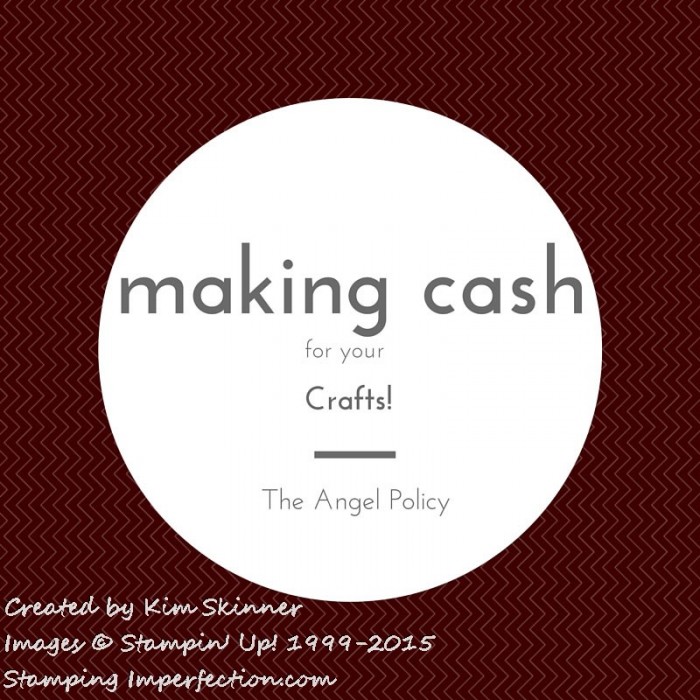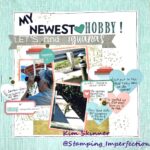If you are planning on Using Stampin’ Up! Images When Selling Your Crafts, you should be aware of Stampin’ Up!’s Angel Policy.

Stampin’ Up! has a legal policy for using their images if you are creating crafts to sell or display online.
|
Angel Policy
Stampin’ Up! welcomes artists who would like to use our copyrighted images in their own handmade craftwork and other projects that they produce to sell. Therefore, we give permission in the form of a limited license to use any Stampin’ Up! images for the purpose of creating items for sale, under the following criteria:
- Handmade craftwork created for sale must be personally and individually created by the selling artist and may not be reproduced or copied in any form by any means, graphic, electronic, or mechanical, including photocopying. Mass production, assembly-line construction, production by workers for hire, or syndication of craftwork for sale is strictly prohibited. Digitally created projects intended for sale must be personally created by the selling artist.
- All of Stampin’ Up!’s images are copyrighted, which means that they may not be copied without permission. To help protect the rights granted by these copyrights, all items for sale using Stampin’ Up! images must be marked with one of the images from the official Stampin’ Up! Limited License stamp sets shown in the catalog, or the digital copyright image included in the My Digital Studio program, or available online.
- There are no quantity limits for for-sale, handmade craftworks that abide by the restrictions as stated in this policy. However, you may only sell 150 total individual items per calendar year of printed projects that were digitally created containing Stampin’ Up! images unless other permission has been requested and granted. Calendars, cards, photo books, or other digitally created projects apply to this limit.
- Completed, handmade or digitally created projects may be sold at competitive and non-competitive permanent retail locations, as well as temporary craft events, community fundraisers, and over the Internet. In selling handmade or digitally created projects, the seller must make it clear that the items are handmade or personally created by the seller, and not a product of the company. The seller may indicate that the supplies used are from Stampin’ Up!, but the Stampin’ Up! logo may not be used in any way for the sole purpose of promoting the sale of handmade or digitally created projects.
- You may not use Stampin’ Up! images for the purpose of creating logos or company trademarks.
- Digital files of any type containing Stampin’ Up! images may not be sold under any condition.
- Persons creating handmade or digitally created items for sale are responsible for complying with any state and local business and tax regulations.
- Persons participating in this angel policy assume all liability for suitability of their work and agree to indemnify Stampin’ Up! from disputes arising from their work.
- Stampin’ Up! is a Utah corporation. The laws of the State of Utah govern the policy. The state and federal courts for Salt Lake County, Utah, will have exclusive jurisdiction over any proceeding arising from this policy and Salt Lake County, Utah shall be the exclusive venue. Any failure by Stampin’ Up! to enforce any of its rights will not constitute a waiver of such rights
|
|
The bottom line is that if you are posting your stuff on a blog or online, you need to post the Stampin’ Up! copyright as a watermark on the images and as a statement on the blog. You can see how I’ve done that on the photo at the top of this blog post. (Note…that is not a Stampin’ Up! image, it is from Canva.com. I’m using it to show you what I mean.) You can see the blog statement either in the column on the side of this page or at the very bottom of this page depending on the device you are viewing this on.
If you are selling a product using the image, you have to include one of the images from the official Stampin’ Up! Limited License stamp sets shown in the catalog.
There are 3 in this stamp set shown below…any stamp with the © Stampin’ Up! image is an acceptable limited license stamp to add to the product you are selling.
You can stamp the Stampin’ Up! copyright on the back of your product and include your own personal stamp so they know who made it as well.
 When in doubt, don’t hesitate to call Stampin’ Up! directly and ask. They have a wonderful customer service department fully equipped to answer your questions about this!
When in doubt, don’t hesitate to call Stampin’ Up! directly and ask. They have a wonderful customer service department fully equipped to answer your questions about this!
Personally, I love my paper crafting hobby and I find it rewarding to share it with other people. It’s even more rewarding when you can use your talents to have your hobby pay for itself!
A lot of us use our crafts to supplement our incomes, whether we do it for fun or for financial need. It is somehow extremely satisfying to have that hobby and to use your talents to support your family or to provide those little extras for special occasions.
No matter what companies products you use, make sure you are aware of their Angel Policy conditions. Most companies have policies of some sort if you are using their products to create things to sell.
Thank you for stopping by today!
You can shop online at mystampingstore.com and put your hobby to work for you!
 When in doubt, don’t hesitate to call Stampin’ Up! directly and ask. They have a wonderful customer service department fully equipped to answer your questions about this!
When in doubt, don’t hesitate to call Stampin’ Up! directly and ask. They have a wonderful customer service department fully equipped to answer your questions about this!







Thanks for posting, Kim! I’m pretty new to Stampin’ Up, and have fallen in love with it so much that I decided to sell some of my cards. I had no idea about the Angel Policy though, so I’m so glad I found you through Pinterest!
Hi there
What about selling boxes using stampin up dsp or cardstock? I stamp my own dsp for some boxes but would I need the @stampin up image on those too?
I believe that if you use the stamped images in any way, you need to use the Angel Policy stamps. Instead of doing that directly on your project, perhaps you could stamp it on the back of your business card that you attach to the project.
Thank you for that great suggestion! I’ve only just seen this reply so apologies for the late reply to your comment.